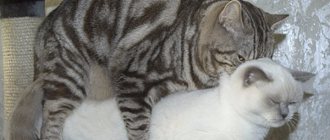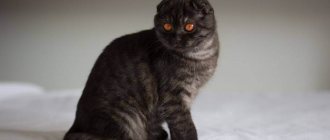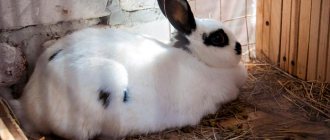11409Pavel
1
When deciding for the first time to start breeding Scottish Fold cats for commercial purposes or for themselves, the owner must know exactly everything about the birth of kittens. In most cases, the birth of a Scottish cat takes place without complications, and the four-legged mother only needs the support of the owner for a more comfortable birth of the kittens.
During pregnancy, a cat requires high-quality nutrition and careful monitoring of its condition. If the mating was the first and the Scottish female is still too young, she can give birth to only one kitten.
More mature cats that give birth more than once give birth to 5 to 7 kittens. The duration of labor in a normal course can last up to a day. Pregnancy lasts from 56 to 71 days, most often the birth of kittens occurs on the 65th day.
© shutterstock
At what age can you knit tartan?
The first heat in Scottish cats, like in other cats, should be expected at 8 months. However, the body has not yet finished growing, and early pregnancy can undermine the health of the pet. And the offspring of a precocious mother will not be in good health.
Scots are considered large pets, so they are ready for the first mating later than cats of smaller breeds. The optimal age for the first pregnancy is one and a half years.
A partner for the Scottish female should be looked for several months before the intended mating, preferably not far from home, in order to have time to connect the couple on the 2nd or 3rd day of estrus.
Preparing the birth site
For the normal birth of kittens, a fold-eared cat, like any other, requires comfortable conditions. The birth box should be prepared in advance so that the pet has time to get used to it. It is very important that the environment in which the cat will give birth is homely and familiar to her. The birth box needs at least the following dimensions :
- length – 60 cm;
- width – 50 cm;
- height – 50 cm.
If the cat is very large, a larger box may be required. It is best to make one of its walls removable. This will allow, after the kittens are born, to carry out all the necessary actions to keep the bedding clean with the least amount of worry, and will also prevent the cat from jumping into the box from above, during which she could accidentally injure, or even kill, the kitten. The ideal bedding would be a thick layer of newspaper.
The kitten birth box should be placed in a warm, dry room in a dark place. The birth should take place without people or animals being strangers to the cat, which can become an additional source of stress for the Scottish cat, which will make the birth process more difficult.
Signs of pregnancy in Scottish cats
After mating, the cat calms down and becomes imposing. If the pet does not have contact with other animals at this time and eats according to its needs, the onset of pregnancy proceeds without problems. The first signs of pregnancy are observed 2-3 weeks after conception. The cat, as well as the woman, experiences attacks of morning sickness, characteristic of toxicosis of pregnancy.
The pet's nipples begin to turn pink, and the hair around them gradually falls out. However, such changes are individual and ultrasound is a reliable test for pregnancy. The first examination is usually carried out 3 weeks after mating.
Be sure to read:
Can a cat give birth to one kitten if the fetus is in the birth canal, what to do?
Even an inexperienced owner can determine that a cat is pregnant in the sixth week of gestation. By this time, her belly is rounded, her nipples swell, and her mammary glands enlarge.
Owner's actions during childbirth
If cats are bred by a cattery, then giving birth to a cat is nothing new for the owners, and they can accurately and quickly do everything necessary. Those who are giving birth to a Scottish cat for the first time need to prepare everything they need in advance and remember exactly the order of their actions.
It is important to calm the pet down and lay it on its side, as this position is the safest for newborn kittens and most comfortable for the cat. If the Scottish female tries to sit up, which sometimes happens in first-time mothers, this should be prevented, since otherwise both the kittens and the mother will be injured. Childbirth in a Scottish Fold cat usually takes place without extreme situations, which does not happen with all breeds.
As soon as the pet begins to give birth and contractions appear (they can be determined by the wave-like movements of the abdomen), she should be injected subcutaneously with 1 ml of Traumatine and Gamovit. You should not combine medications in 1 syringe. This is required to facilitate childbirth and quickly recover after it.
The first kitten born immediately begins to suckle from its mother, which stimulates labor and facilitates the birth of other kittens.
© shutterstock
Behavior of a pregnant fold cat
A pregnant cat changes its behavior. Hormonal surges change behavior. The cat alternately pets and looks irritated. Fetal development increases food requirements during the fourth week of pregnancy. At that time, the feed portion can be increased by 10-15%. In subsequent weeks, the animal is no longer restricted in food, but in order to avoid overeating, it is fed in small portions, but often.
The best option is to switch to ad libitum feeding with dry granules. The fifth week of pregnancy has only just begun, and the Scotswoman is already beginning to nest: she is looking for a secluded place. If the owners are planning to purchase a cat house, then this time is most suitable for the implementation of the intention.
During the seventh week, the cat may lose its appetite for a while. The embryos begin to grow fur and the cat hibernates at this time. The body is rebuilt, some of the nutrients are redirected into the formation of fruits to prepare the mammary glands for lactation. This process requires calmness, so the cat becomes drowsy.
In the last weeks before lambing, the Scotch cow becomes active again, once again walking around the property in search of a more convenient nest. It's time to satisfy your curiosity and repeat the ultrasound. You can determine the number of fruits and observe their movements. However, someone may be undetected and the actual number of kittens turns out to be greater than expected.
Possible complications
Childbirth does not always go flawlessly. Unforeseen and not very pleasant consequences may develop.
The cat cannot give birth to her first kitten
It happens that at the beginning of labor a problem arises with the very first baby. Perhaps the fetus is large, or its location is not normal. When the process has been going on for an hour, and the cat cannot give birth, it is necessary to urgently call a doctor.
If the baby gets stuck, the mother in labor will need help. In this situation, the cat owner must:
- Take Vaseline oil into a pipette and lubricate the birth canal.
- When the presenting part of the kitten appears, immediately press on the part of the perineum located below the anus.
- Grab the animal by the skin in the withers area (through a sterile cloth) and, while the cat is pushing, slightly pull it towards you.
- Gently hold the baby's head between your fingers;
- start shaking back and forth (like “chopping wood”), after every 3-4 shakes, rub the kitten’s chest, blow into the nose;
- Place the squealing baby next to the mother.
It is better to immediately place the successfully extracted animal in the mother's body; she will do the rest herself. If the Scottish cat does not lick the newborn, he needs to be wiped with a damp cloth, his nose and mouth should be freed of mucous masses using a small enema and placed back with the cat.
Dead kittens
If the newborn is not breathing, you can try to bring him back to life. The cat owner will have no more than 5 minutes to do this. If during this time the animal does not give a voice, further resuscitation will be useless.
The sequence of actions is as follows:
If the baby does not come to life, you can apply cotton wool with ammonia to his nose. The most radical way is to dip the kitten alternately in warm and cool water. This stimulates the heartbeat. The revived baby's nose and tongue turn pink.
It happens that a cat does not want to lick a child who has already been in the wrong hands. In this case, you need to take a piece of damp gauze, massage the baby's anorectal area to induce bowel movements, and place the baby again next to the cat.
The placenta did not come out
If after the birth the cat is in a nervous, restless state, there may be some placenta left inside. This can lead to the development of inflammatory processes and intoxication.
You should call a veterinarian as soon as possible. No animal owner can cope with this problem on their own.
Prolonged labor
If all the signs of the first stage of labor are observed, the animal is suffering, but does not give birth, despite strong attempts, the help of a doctor will be needed. The cat should be taken to the clinic as soon as possible and x-rayed.
Signs of prolonged labor are:
- absence of kittens 1–2 hours after the start of the process during strong contractions;
- the appearance of sudden weakness in a cat against a background of elevated temperature (40°C or more).
If bleeding starts and does not stop within 5–8 minutes, you should urgently call a doctor. The best option would be to transport the cat to a veterinary clinic.
What to feed a pregnant Scottish Fold cat
No special food has been developed for pregnant and lactating cats. Manufacturers of ready-made food believe that the nutritional needs of a mother cat are the same as those of kittens. Therefore, it is recommended to switch a pregnant pet to baby food from the moment pregnancy is considered established.
Be sure to read:
A pregnant cat has bleeding: normal or pathological, what to do when you need help
That is, if on the 25th day after mating an ultrasound showed the presence of embryos, the pet begins to gradually replace the previous food with a new one. This should be done gradually over a week to prevent feeding stress, which will negatively affect the fruit.
If an ultrasound was not performed for some reason, the transition to a new food begins when pregnancy is established based on other signs.
Malyshovsky food is as close as possible to milk in terms of energy and protein concentration, therefore it contains a lot of fat. For this reason, it should not be given immediately after mating, since Scottish females are prone to obesity.
The best option is universal holistic food such as Acana or Orijen, or specialized food Royal Canin Mother & Babycat. Adherents of natural food should create a diet that is not inferior in nutritional value to the indicated ready-made food.
Helping a newborn kitten
When talking about how a Scottish cat gives birth, one cannot lose sight of the moment of providing assistance to a newly born kitten. Babies are born in a bubble, and if the cat does not immediately begin to care for them, the owner must do everything.
The sequence of actions will be as follows:
- rupture of the bladder at the level of the kitten’s nose;
- removing mucus from the nasal passages using a syringe (the nozzle of the syringe is carefully placed against the nostril and the mucus is sucked out, the procedure is carried out for both nostrils);
- dispersing blood from the umbilical cord with your fingers towards the kitten’s stomach;
- cutting the umbilical cord at a height of 2 cm from the baby’s tummy (you can rub the umbilical cord with your nails);
- Drying the newborn with a clean soft cloth.
Special veterinary training is not required for these manipulations. A healthy kitten begins to squeak and move actively as soon as it is dried.
After giving birth, the cat’s behavior returns to normal, and she begins to take care of the babies , which she was not interested in at the first moment after their appearance, due to a stressful state.
How to help a Scottish woman during childbirth
The first aid before lambing is preparing the den. The simplest option is a cardboard box with holes cut for ventilation, lined with paper and covered with a soft cloth. The future house for kittens is placed in a secluded place. The nesting cat is picked up and placed in a prepared place. If the cat shows willfulness and lambs in another place. She, along with her offspring, is placed in a prepared den, from which she will never leave.
It is good if a veterinarian is present during the birth, but most owners can provide assistance on their own. Most often, the cat copes on its own.
Be sure to read:
Miscarriage in a cat: symptoms, reasons, what to do, why kittens are born dead
Labor begins with the release of amniotic fluid. The kitten is born in the amniotic sac, which bursts and the cat gnaws the umbilical cord. If she did not do this, you need to cut the cord with sterile scissors and treat the stump with tincture of iodine. The mother usually eats the placenta. This is normal, but you should not allow more than two placentas to be eaten. When the cat has the intention of eating another afterbirth, food is added to it.
If the bubble does not open on its own, it is broken with your fingers. The kitten is shaken, the liquid is removed from the mouth with a baby syringe and placed on the mother.
The normal interval between the births of kittens is considered to be a quarter of an hour. All afterbirths come out within half a day after the birth of the last kitten. If labor is difficult, call a veterinarian.
Behavior by week
First - third week. At the very beginning, the pussy becomes very lazy, sleeps a lot, and may not eat. But she constantly caresses, asks for love and ironing.
The nipples become pink, and sometimes there is nausea. At this time, provide her with enough human warmth, caress her, speak in a calm voice, pay attention, because she needs it. Try to explain to the children, if you have them in your house, so that they do not disturb her again, do not carry her in their arms and do not wake her up if she falls asleep. This should be done throughout the entire period.
Fourth – sixth week. You will notice that the female has become rounder in the sides; if you gently touch the tummy, you can feel the embryos there. Make sure that she does not show excessive activity, because her center of gravity is now shifted and she may not be able to maintain her balance. Clumsiness is dangerous and causes injury, so remove any chairs that she can jump on and end up on top of a cabinet, etc. If you see that it has nevertheless climbed somewhere, carefully remove it without putting pressure on the belly.
Seventh – ninth week. The animal's mobility is completely limited, it sleeps a lot and walks around all the rooms, inspecting the corners. This is a search for a place for babies to be born. You need to prepare a box, soft cloth and everything you need to deliver the baby. There is no need to disturb or irritate the animal; you should reduce the amount of food and monitor it - the process can begin at any time.
The Scottish breed is artificially bred, so the instincts may not be as strong as in others; be prepared to provide assistance, cut the umbilical cord, take the Scottish dog to the veterinary clinic or call a doctor at home. In any case, keep the hospital phone number at hand, if necessary, they can provide you with advice.
Factors contributing to successful mating
Domestic cats become sexually mature at 6–8 months, depending on the breed and individual characteristics. Neither males nor females are ready for full mating in the first “hunt”. Stray animals mate at this age, which leads to death or infertility in an average of 30% of females, a reduction in sexual productivity in 50% of males - a natural way of controlling the birth rate and population of wild animals.
It is believed that the female is ready to bear kittens at the age of 1.3–1.5 years. For successful “cooperation” with a cat, the owners of the female need to take into account several points:
The search for a “spouse” may take a long time; you need to start 4–6 months before the planned mating. Remember that animals may not like each other, so have a backup plan.
Three months before mating, cats must be examined for infectious diseases, and tested for viruses a month before.
The cat is not vaccinated for 14–20 days.
Preventive deworming is carried out 14 days in advance.
Future partners do not bathe and trim their nails immediately before mating.
The meeting takes place on the territory of the cat; appropriate conditions must be prepared for the female.
Preparing for childbirth
What needs to be prepared for the birth of a cat
The owner must remember the estimated date of future birth. It is also necessary to understand that they may occur ahead of schedule, so the first aid kit should be prepared in advance:
- scissors with blunt ends for cutting the umbilical cord;
- disinfectants;
- diapers to dry babies if necessary;
- a small enema to clear the kittens' airways of fluid;
- clean bedding to move the cat family onto after giving birth;
- Doctor's phone number. It is worth pre-arranging with the veterinarian the date when he may need to come to your home.
As mentioned above, the cat needs to be provided with a corner where she can give birth to kittens. This could be a clean box or basket. You need to place it in a quiet place without drafts. The bedding should be warm and pleasant to the touch. For the birth itself, it is worth using unnecessary material, since after the process is completed it will no longer be suitable.
Prepare the place for childbirth
If a cat carries kittens for more than 68 days, you need to contact a veterinarian to check the health of the expectant mother.
Possible complications of pregnancy, how to identify them in the early stages
Great risks are associated with mating after any kind of surgery. If a cat has survived anesthesia, its health has received a serious “blow” and you can start talking about mating only after the veterinarian’s permission and a comprehensive examination. In any case, mating is not planned until complete rehabilitation, sutures have been secured and scar tissue has formed.
Some cat breeds are notoriously problematic in terms of bearing offspring and childbirth. Pedigree breeders know about the pitfalls, but if you are not an experienced owner and have a purebred cat, be sure to consult the club about possible complications.
Bearing and giving birth to kittens in a British cat is associated with certain risks. The significant superiority in size of the male over the female, the majority of large kittens and the narrow pelvis of the cat can negatively affect the birth process. Problems are more common in Scottish cats due to genetic mutations. This does not mean that the animal is not able to give birth, but only that it needs to be given more attention and examined in detail. The Sphynx is a more problematic pet in terms of childbirth and new obstetricians are not recommended to deliver babies on their own. However, thanks to the control of widespread crossbreeding and the comparative “freshness” of the blood, only 10–15% of cats “fall” under caesarean section, which cannot be said about Persian, “new” Siamese, oriental cats.
What to do with newborn kittens
After the first kitten is born, cut the umbilical cord 2 cm from the tummy. Then tie it with thread and disinfect it. After this, you need to place the baby near the mother's nipples. This way she can lick him and feed him. The final stage for you: it is recommended to wipe the baby with a dry cloth after the first feeding. After this, place him on a warm heating pad. Do the same with the rest of the kittens.
When the due date comes, take care of the newborn babies and the mother in labor. Sometimes this process turns out to be difficult and lengthy, especially if the Scottish woman gives birth for the first time. Be patient and you can get beautiful Scottish kittens.
First signs of labor
The first signs of labor in a Scots cat can be seen just before the kittens appear. It would not be amiss to note that in a British cat everything happens in a similar way. In the period before birth, about 30 hours before it, the cat's rectal temperature changes and is only 37 degrees instead of 38.6 (as usual), but it recovers within a few hours. This sign of approaching labor can sometimes be missed due to its transience.
On the day of birth, your pet’s behavior changes, she begins to actively lick the genital area, as well as the abdomen, becomes restless, actively purrs and rummages in the prepared box or place that she herself has chosen as a birthing area. The beginning of labor for tartans is considered to be the moment the plug comes out, which can be determined by the release of bloody clots or a brown jelly-like mass.
Post-term pregnancy
A post-term pregnancy is a pregnancy that lasts up to 70 days or more. The normal delay in labor is one week if the mother feels well. Delay does not always lead to pathologies or unhealthy kittens, but it is also not considered the norm.
Reasons for delayed birth:
- If the offspring is expected to be small, then gestation will be longer.
With small offspring, pregnancy lasts longer
- Also, the period may be delayed if the cat was exposed to stress in the last stages.
- Larger and older Scottish females bear offspring longer.
- An older cat may have a longer period if she gives birth for the first time.
- Frozen pregnancy.
- Hypoxia in kittens is an insufficient amount of oxygen supplied.
An ultrasound will show the exact cause of the delay.
Preparing the birth site
For the normal birth of kittens, a fold-eared cat, like any other, requires comfortable conditions. The birthing box should be prepared in advance so that the pet has time to get used to it
It is very important that the environment in which the cat will give birth is homely and familiar to her. The birth box needs at least the following dimensions:
- length – 60 cm;
- width – 50 cm;
- height – 50 cm.
If the cat is very large, a larger box may be required. It is best to make one of its walls removable. This will allow, after the kittens are born, to carry out all the necessary actions to keep the bedding clean with the least amount of worry, and will also prevent the cat from jumping into the box from above, during which she could accidentally injure, or even kill, the kitten. The ideal bedding would be a thick layer of newspaper.











